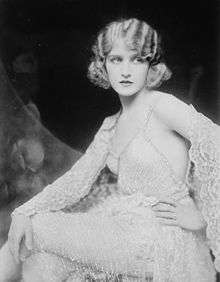Mary Eaton
| Mary Eaton | |
|---|---|
 | |
| Born |
Mary Eaton January 29, 1901 Norfolk, Virginia, U.S. |
| Died |
October 10, 1948 (aged 47) Hollywood, California, U.S. |
| Cause of death | cirrhosis of the liver |
| Years active | 1924-1942 |
| Spouse(s) |
Millard Webb (1929-1935) (his death) Charles A. Emery (1937-1942) (divorced) Eddie Laughton (?-1948) (her death)[1] |
Mary Eaton (January 29, 1901 – October 10, 1948) was a leading American stage actress, singer, and dancer in the 1910s and 1920s. A professional performer since childhood, she enjoyed success in stage productions such as the Ziegfeld Follies and early sound films such as Glorifying the American Girl and The Cocoanuts, but found her career in sharp decline by the mid-1930s. A battle with alcoholism led to her death in 1948 from liver failure.
Early life and career
Eaton, a native of Norfolk, Virginia, began attending dance lessons in Washington D.C., along with her sisters Doris and Pearl, at the age of seven. In 1911, all three sisters were hired for a production of Maurice Maeterlinck's fantasy play The Blue Bird at the Shubert Belasco Theatre in Washington. While Eaton had a minor role in the show, it marked the beginning of her career in professional theatre.
After The Blue Bird ended, in 1912, the three Eaton sisters and their younger brother Joe began appearing in various plays and melodramas for the Poli stock company. They quickly gained reputations as professional, reliable, and versatile actors, and were rarely out of work.
In 1915, all three sisters appeared in a new production of The Blue Bird for Poli; Doris and Mary were given the starring roles of Mytyl and Tytyl. The siblings were subsequently invited to reprise their roles for a New York and road tour of the play, produced by the Shubert Brothers. When the show closed, on the recommendation of the Shuberts, Mary began studying ballet in earnest with Theodore Kosloff.
Success onstage and onscreen
Of all of the Eatons, Mary was perhaps the most famous and the most popular. An exceptionally talented dancer, she earned raves in a production of Intime in Washington DC in 1917. The same year, she made her Broadway debut in the Shubert Brothers' Over the Top with Fred and Adele Astaire. Throughout the 1920s, Eaton was a constant presence on Broadway, appearing in eight different productions.
She was featured in three editions of the Ziegfeld Follies, those of 1920, 1921, and 1922. Eaton's trademark dance routine, which she performed in the Follies, involved a complicated sequence of pirouettes around the stage en pointe.
Eaton also had a brief film career, appearing in two important early talkies: The Cocoanuts (1929) with the Marx Brothers (in which she reprised her role from the Broadway version) and Glorifying the American Girl (1929), which included a brief Technicolor sequence, was produced by Flo Ziegfeld, included a cast of stage notables, and was shot on location in New York. Eaton's singing and dance routines, including her signature pirouette sequence, were featured. The film's commercial failure, however, signaled the end of Eaton's starring career onscreen.
Decline
Many of the Eaton siblings, including Mary, found their careers in sharp decline in the early 1930s. She made her final stage appearance in 1932. Beset by career woes and three consecutive difficult marriages, Eaton struggled with alcoholism. Although her siblings tried to intervene on numerous occasions and she entered rehabilitation programs several times, she was unable to overcome her addiction.
Eaton died of liver failure at the age of 47 in Hollywood, California. She was buried in Forest Lawn Cemetery in Los Angeles alongside other members of the Eaton family.
Partial filmography
- His Children's Children (1923)
- The Cocoanuts (1929)
- Glorifying the American Girl (1929)
- We'll Smile Again (1942)
See also
References
- Travis, Doris Eaton. The Days We Danced, Marquand Books, 2003, ISBN 0-8061-9950-4
External links
| Wikimedia Commons has media related to Mary Eaton. |
- Mary Eaton at the Internet Broadway Database

- Mary Eaton at the Internet Movie Database
- Mary Eaton at Find a Grave